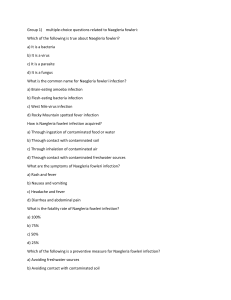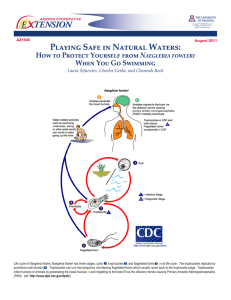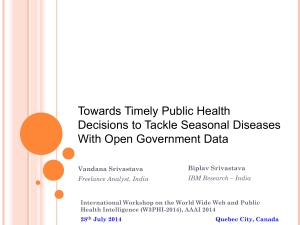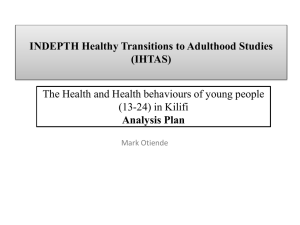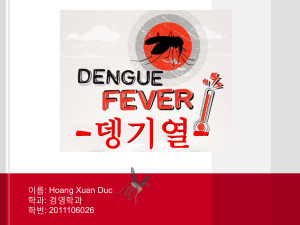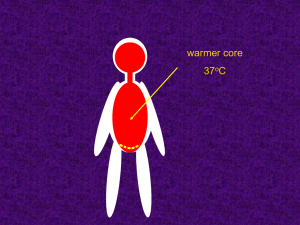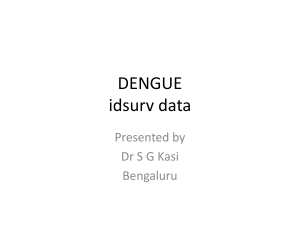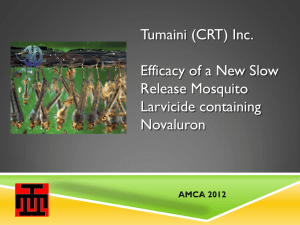Vector-Borne & Water
advertisement
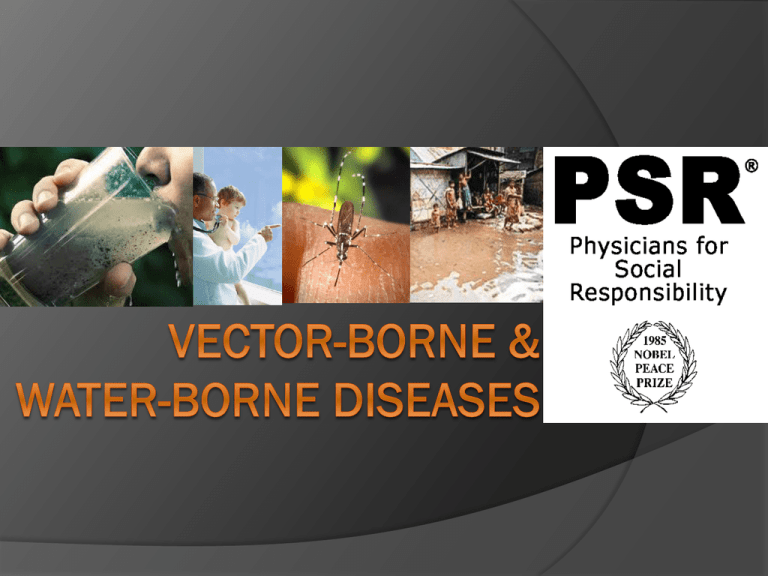
Question #1 Name three climatic factors that influence the survival rates and range of disease vectors: Question #2 Which vector-borne disease is transmitted via the Asian Tiger mosquito? a) b) c) Malaria Dengue Fever West Nile Virus Question #3 Describe 5 ways that the spread of vectorborne diseases can be prevented: Question #4 Which water-borne disease is also known as “the brain-eating ameoba”? a) b) c) Cholera Norovirus Naegleria Fowleri Question #5 Describe 5 ways that the spread of waterborne diseases can be prevented: What is a Vector-Borne Disease? Vectors are insects (mosquitoes, ticks, fleas, black flies and sandflies) that carry infectious agents such as protozoa, bacteria and viruses. They carry and transmit numerous diseases to humans: parasitic vectorborne diseases, arboviral diseases, and bacterial and rickettsial diseases Climate Change Promotes Vector-borne Disease Warmer temperatures Increased precipitation Increased humidity Malaria Vector: Mosquito Transmission: Bite from an infected mosquito Prevalence: Estimated 219 million cases of malaria worldwide, resulting in the deaths of approximately 660,000 people. US Prevalence: An average of 1,500 reported cases of malaria in the U.S. each year. Global Prevalence of Malaria (CDC) Malaria: Symptoms & Outcomes Mild Symptoms: Severe Symptoms Fever Headaches Nausea and vomiting Body aches Neurologic abnormalities Severe anemia Low blood pressure Acute kidney failure Possible Outcomes: Acute respiratory distress syndrome death Dengue Fever Vector: Asian tiger mosquito, which can be found in 36 states in the U.S. Transmission: Bite from an infected mosquito Prevalence: 100 million cases of dengue worldwide each year. The disease is now endemic in many countries of the Americas. US Prevalence: Occurs rarely, but there is a small risk for dengue outbreaks in the continental United States. Dengue Fever: Symptoms & Outcomes U.S. Disease Vulnerability 1995-2005 Mild Symptoms: Joint pain Rash Severe Symptoms: Severe headache severe pain behind the eyes muscle and bone pain mild bleeding persistent vomiting severe abdominal pain difficulty breathing Possible Outcomes: If not treated, this may lead to failure of the circulatory system and shock, and eventually death. West Nile Virus Vector: Mosquito Preliminary July 2013 WNV Activity (CDC) Transmitted: Bite from an infected mosquito Prevalence: WNV is commonly found in Africa, Europe, the Middle East, North America and West Asia. U.S. Prevalence: Between 1999 and 2012, about 37,000 cases of West Nile Virus were reported in the U.S. Over 1,500 people died as a result.8 West Nile Virus: Symptoms & Outcomes 70-80% of those who become infected will not experience any symptoms Mild Symptoms (20%): fever headache body aches joint pains vomiting diarrhea rash Severe Symptoms (<1%): encephalitis meningitis coma paralysis Global Prevalence of WNV Bubonic Plague Vector: Fleas Transmission: Bite from an infected flea, contact with contaminated fluid or tissue, infectious droplets Prevalence: 1,000 - 2,000 cases each year U.S. Prevalence: 999 cases in the U.S. between 1900 and 2010. Cases in the U.S. have shifted northward as temperatures have warmed. Bubonic Plague: Symptoms & Outcomes Mild Symptoms: Swollen lymph glands Fever Headache Chills Weakness Severe Symptoms: Progress into Pneumonic Plague Possible Outcomes: Death Image source: CDC Lyme Disease Vector: Deer tick Transmission: Bite from an infected deer tick Prevalence: Areas of Asia, north-western, central and eastern Europe, and the USA. U.S. Prevalence: Most commonly reported vectorborne illness in the United States, heavily concentrated in the Northeast and upper Midwest. Lyme Disease: Symptoms & Outcomes 3 – 30 days: Bulls eye rash, Fatigue, Chills, Fever, Headache, muscle and joint aches, swollen lymph nodes Days to weeks: Additional Bulls eye rash, facial or Bell's palsy, severe headaches and neck stiffness due to meningitis, pain and swelling in the large joints Months to years: arthritis, severe joint pain and swelling. Image courtesy of CDC Division of Vector-Borne Infectious Diseases Prevention: Vector-borne Disease Avoid areas with vector-borne disease outbreaks Be aware of peak exposure times and places Wear long sleeves and pants Check for ticks Bed nets Insecticides and spatial repellents What is a Water-Borne Disease? “Pathogenic microbes that can be directly spread through contaminated water.” -CDC Humans contract waterborne infections by contact with contaminated water or food. May result from human actions, such as improper disposal of sewage wastes, or extreme weather events like storms and hurricanes. Climate Change Promotes Water-borne Disease Rainfall: transport and dissemination of infectious agents Flooding: sewage treatment plants overflow; water sources contaminated Sea level rise: enhances risk of severe flooding Higher temperatures: Increases growth and prolongs survival rates of infectious agents Drought: increases concentrations of pathogens, impedes hygiene Cholera Found in water or food sources contaminated by feces from an infected person Transmitted by contaminated food, water Prevalence increases with increasing temperature and rainfall amounts Global Prevalence of Cholera (WHO) Cholera: Symptoms & Outcomes Often mild or without symptoms Severe Symptoms (5%): diarrhea vomiting leg cramps Possible Outcomes: dehydration shock death Image Source: CDC Norovirus Transmission: infected person to person contaminated food or water contaminated surfaces Causes ~ 21 million illnesses, contributes to about 70,000 hospitalizations and 800 deaths each year. Most common cause of acute gastroenteritis in the United States Norovirus: Symptoms & Outcomes Symptoms: diarrhea vomiting nausea stomach pain fever headache body aches Possible Outcomes: Dehydration Death Norovirus: Cases Hurricane Katrina Breakout occurred between Sept 2-12 in Houston, TX 1,169 evacuees contracted the norovirus after Hurricane Katrina due to contaminated water Naegleria Fowleri Image Source: CDC Commonly referred to as the "brain-eating amoeba" Causes an infection of the brain Found in warm freshwater and soil Transmitted when contaminated water enters the body through the nose Naegleria Fowleri: Symptoms & Outcomes Mild Symptoms: Severe Symptoms: Headache Fever Nausea Vomiting stiff neck confusion lack of attention to people and surroundings loss of balance seizures hallucinations Possible Outcome: death Naegleria Fowleri: Cases Due to its need for high temperatures, the range of naegleria fowleri was once thought to be limited to lower latitudes. However, warmer temperatures and extreme weather events that may be linked to climate change have allowed conditions necessary for naegleria fowleri to expand northward. 1 death was recorded in Minnesota in 2010. Prevention: Water-borne Disease Improve quality and quantity of drinking water at source, at the tap, or in the storage vessel Interrupt routes of transmission by emptying accumulated water sources Chlorinate water Change hygiene behavior (ex. Hand washing) Take care in disposing of waste and human and animal feces Proper use of latrines by adults and children Proper use and maintenance of water supply, sanitation systems, pumps and wells Good food hygiene (ex. protect food from flies) Question #1 Name three climatic factors that influence the survival rates and range of vectors: 1. 2. 3. Temperature Precipitation Humidity Question #2 Which vector-borne disease is transmitted via the Asian Tiger mosquito? a) b) c) Malaria Dengue Fever West Nile Virus Question #3 Describe 5 ways that the spread of vectorborne diseases can be prevented: 1) Avoid areas with disease outbreaks 2) Be aware of peak exposure times and places 3) Wear long sleeves and pants 4) Check for ticks 5) Bed nets 6) Insecticides and spatial repellents Question #4 Which waterborne disease is also known as “the brain-eating ameoba”? a) b) c) Cholera Norovirus Naegleria Fowleri Question #5 Describe 5 ways that the spread of water borne diseases can be prevented: 1) 2) 3) 4) 5) 6) 7) 8) Improve quality and quantity of drinking water at source, at the tap, or in the storage vessel Interrupt routes of transmission by emptying accumulated water sources Chlorinate water Change hygiene behavior (ex. Hand washing) Take care in disposing of waste and human and animal feces Proper use of latrines by adults and children Proper use and maintenance of water supply, sanitation systems, pumps and wells Good food hygiene (ex. protect food from flies) Join Together for Change www.PSR.org 202-667-4260
